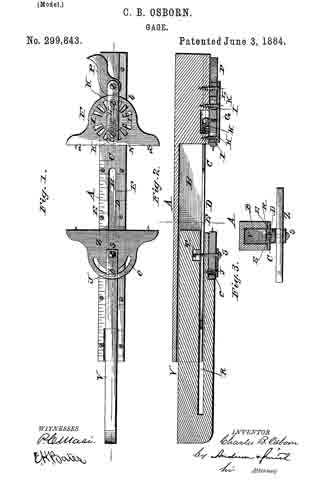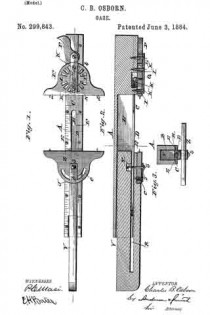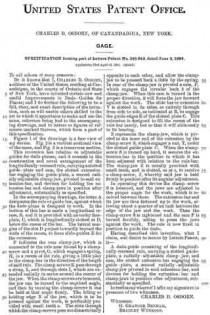
| PLEASE NOTE: The images presented on this page are of low resolution and, as a result, will not print out very well. If you wish to have higher resolution files then you may purchase them for only $2.95 per patent by using the "Buy Now" button below. All purchases are via PayPal. These files have all been cleaned up and digitally enhanced and are therefore suitable for printing, publication or framing. Each zip package contains all the images below (some packages may contain more), and purchased files can be downloaded immediately. |
UNITED STATES PATENT OFFICE.
_________________
CHARLES B. OSBORN, OF CANANDAIGUA, NEW YORK.
GAGE.
_________________
SPECIFICATION forming part of Letters Patent No. 299,843, dated June 3, 1884.
Application filed April 12, 1884. (Model.)
_________________
To all whom it may concern:
Be it known that I, CHARLES B. OSBORN, a citizen of the United States, residing at Canandaigua, in the county of Ontario and State of New York, have invented certain new and useful Improvements in Dado-Guides for Planes; and I do declare the following to be a full, clear, and exact description of the invention, such as will enable others skilled in the art to which it appertains to make and use the same, reference being had to the accompanying drawings, and to letters or figures of reference marked thereon, which form a part of this specifiction.
Figure 1 of the drawings is a face view of my device. Fig. 2 is a vertical sectional view of the same, and Fig. 3 is a transverse section.
This invention has relation to adjustable guides for dado-planes; and it consists in the construction and novel arrangement of the longitudinally-recessed rule, carrying a slotted guide-plate and cam, the slotted extension-bar engaging the guide-plate, a second radially-adjustable clamp-jaw, pivoted to said extension-bar, and devices for holding the extension-bar and clamp-jaws in position after adjustment, substantially as specified.
In the accompanying drawings, the letter A designates the rule or guide-bar, against which the dado-plane is designed to work. In the bottom of this bar is made a longitudinal recess, B, and it is provided with an under face-plate, C, which is longitudinally slotted at D, below the recess of the bar. The lateral margins of the slot D project inwardly beyond the walls of the recess, to forrn slide-guides E for the extension.
F indicates the rear clamp-jaw, which is connected to the rule near its end by a clamp-screw and a pivot, G, which engages a spring, H, in a recess of the rule, giving a little play to the clamp-bar in the direction of the length of said rule. The clamp-screws K pass through a strap, L, and through slots I, which are extended radially in series around the center of the jaw. When the clamp-screws are loosened, the jaw can he turned to the required angle, and then by turning the clamp-screws it can be held at that angle firmly. The biting or holding edge N of the jaw, which is to be pressed against the work, is preferably provided with small teeth a. The slots through which the clamp-screws pass are diametrically opposite to each other, and allow the clamp-jaw to be pressed back a little by the spring. In rear of the clamp-jaw is pivoted a cam, P, which engages the circular back b of the clamp-jaw. When this cam is turned in the proper direction, it will force the jaw forward against the work. The slide bar or extension V is slotted in its sides, or entirely through from side to side, as indicated at R, to engage the guide-edges E of the slotted plate C. This extension is designed to fill the recess of the rule-bar neatly, but so that it will slide easily in its bearing.
Z represents the clamp-jaw, which is pivoted to the inner end of the extension by the clamp-screw S, which engages a nut, T, under the slotted guide-plate C. When the clamp-screw S is turned up hard, it secures the extension-bar in the position to which it has been adjusted with relation to the rule-bar. The clarnp-jaw Z is usually provided with small teeth, and is slotted, as at c, to receive a clamp-screw, J, whereby said jaw is held firnily in position after its angular adjustment.
In operating this device the clamp-screw S is loosened, and the jaws are adjusted to the proper angle for the work, which is received between them. The extension-bar and its jaw are then fastened up to the work, allowing about a quarter of an inch between the edge of the jaw and the work. Then the clamp-screw S is tightened and the cam P is turned forcibly, acting to press the jaws against the work. The rule is now fixed in position to guide the dado.
Having described this invention, what I claim, and desire to secure by Letters Patent, is —
A dado-guide consisting of the longitudinally-recessed rule, carrying a slotted guide-plate, a radially-adjustable clamp-jaw, and cam, the slotted extension-bar engaging the guide-plate, a second radially-adjustable clamp-jaw pivoted to said extension-bar, and devices for holding the extension-bar and clamp-jaws in position after adjustrnent, substantially as specified.
In testimony whereof I affix my signature in presence of two witnesses.
CHARLES B. OSBORN.
Witnesses:
G. GRANGER BENHAM,
BRADLEY WYNKOOP.


